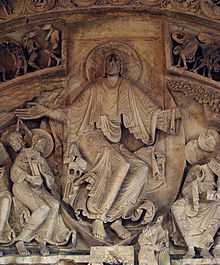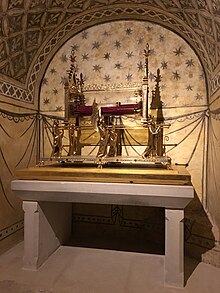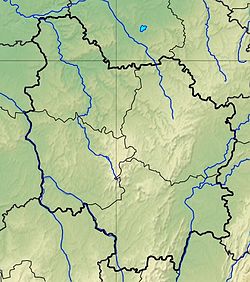Vézelay Abbey
| UNESCO World Heritage Site | |
|---|---|
 The abbey church in Vézelay | |
| Location | Burgundy, France |
| Criteria | Cultural: i, vi |
| Reference | 84 |
| Inscription | 1979 (3rd Session) |
| Area | 183 ha |
| Buffer zone | 18,373 ha |
| Website | www |
| Coordinates | 47°27′59″N 3°44′55″E / 47.46639°N 3.74861°E |
Vézelay Abbey (
The church and hill at Vézelay were added to the
Relics of Mary Magdalene can be seen inside the Basilica.
History
The Benedictine
About 1050 the monks of Vézelay began to claim to hold the relics of Mary Magdalene, brought, they said, from the Holy Land either by their 9th-century founder-saint, Badilo, or by envoys despatched by him.[4] A little later a monk of Vézelay declared that he had detected in a crypt at St-Maximin in Provence, carved on an empty sarcophagus, a representation of the Unction at Bethany, when Jesus' head was anointed by Mary of Bethany, who was assumed in the Middle Ages to be Mary Magdalene. The monks of Vézelay pronounced this to be Mary Magdalene's tomb, from which her relics had been translated to their abbey. Freed captives then brought their chains as votive objects to the abbey, and it was the newly elected Abbot Geoffroy in 1037 who had the ironwork melted down and reforged as wrought iron railings surrounding the Magdalene's altar.[4] Thus the erection of one of the finest examples of Romanesque architecture which followed was made possible by pilgrims to the declared relics and these tactile examples demonstrating the efficacy of prayers. Mary Magdalene is the prototype of the penitent, and Vézelay has remained an important place of pilgrimage for the Catholic faithful, though the actual claimed relics were torched by Huguenots in the 16th century.

To accommodate the influx of pilgrims a new abbey church was begun, dedicated on April 21, 1104, but the expense of building so increased the tax burden on the abbey's lands that the peasants rose up and killed the abbot. The crush of pilgrims was such that an extended narthex (an enclosed porch) was built, inaugurated by Pope Innocent II in 1132, to help accommodate the pilgrim throng.
Saint Bernard of Clairvaux preached at Vézelay in favor of a second crusade at Easter 1146, in front of King Louis VII. Richard I of England and Philip II of France met there and spent three months at the Abbey in 1190 before leaving for the Third Crusade. Thomas Becket, in exile, chose Vézelay for his Whitsunday sermon in 1166, announcing the excommunication of the main supporters of his English King, Henry II, and threatening the King with excommunication too. The nave, which had been burnt once, with great loss of life, burned again in 1165, after which it was rebuilt in its present form.
The abbey's self-assured monastic community was prepared to defend its liberties and privileges against all comers:
The beginning of Vézelay's decline coincided with the well-publicized discovery in 1279 of the body of Mary Magdalene at Saint-Maximin-la-Sainte-Baume in Provence, given regal patronage by Charles II, the Angevin king of Sicily. When Charles erected a Dominican convent at La Sainte-Baume, the shrine was found intact, with an explanatory inscription stating why the relics had been hidden. The local Dominican friars compiled an account of miracles that these relics had wrought. This discovery undermined Vézelay's position as the principal shrine of the Magdalene in Europe.
After the Revolution, Vézelay stood in danger of collapse. In 1834 the newly appointed French inspector of historical monuments, Prosper Mérimée (more familiar as the author of Carmen), warned that it was about to collapse, and on his recommendation the young architect Eugène Viollet-le-Duc was appointed to supervise a massive and successful restoration, undertaken in several stages between 1840 and 1861, during which his team replaced a great deal of the weathered and vandalized sculpture. The flying buttresses that support the nave are his.[6]
Interpretation of the tympanum
The tympanum of the central portal of the Madeleine de Vézelay is different from its counterparts across Europe. From the beginning, its tympanum was specifically designed to function as a spiritual defense of the Crusades and to portray a Christian allegory to the Crusaders' mission. When compared to contemporary churches such as St. Lazare d'Autun and St. Pierre de Moissac, the distinctiveness of Vézelay becomes apparent.
The art historian George Zarnecki wrote, "To most people the term Romanesque sculpture brings to mind a large church portal, dominated by a tympanum carved with an apocalyptic vision, usually the Last Judgment."[7] This is true in most cases, but Vézelay is an exception. In a 1944 article, Adolf Katzenellenbogen interpreted Vézelay's tympanum as referring to the First Crusade and depicting the Pentecostal mission of the Apostles.[8]
Thirty years before the Vézelay tympanum was carved,
The art historian Peter Low argues for the central tympanum as a visualization of both the Pentecost and a passage from book of Ephesians chapter 2—proclaiming to the visiting laity the tenets of Benedictine monasticism and to visiting pilgrims the extent and reach of a universalizing church that welcomes "the full, even monstrous range of the globe's inhabitants."[9]
Lintel

The lintel of the Vézelay portal portrays the "ungodly" people of the world. It is a depiction of the first Pentecostal Mission to spread the word of God to all the people of the world. The figures in the tympanum who have not received the Word of God are depicted as not fully human. Some are shown with pig snouts, others are misshapen, and several are depicted as dwarves. One pygmy in particular is depicted as mounting a horse with the assistance of a ladder. On the far right, there is a man with elephantine ears, while in the center we see a man covered in feathers. The architects and artisans depicted the unbelievers as physically grotesque in order to provide a visual image of what they saw as the non-believers' moral turpitude. This is a direct reflection of Western perceptions of foreigners such as the Moors, who were being specifically targeted by the Crusaders. Even Pope Urban II, in his call for a crusade, helped promote this ethnocentric perception of the Turks by calling on westerners to, "exterminate this vile race."[10] Most Westerners had absolutely no idea what the Turks and Muslims looked like, and they assumed that an absence of Christianity must coincide with repulsive physical attributes. It has also been argued that the disbelievers were carved as deformed monsters in an effort to dehumanize them. By dehumanizing their enemies in art, the Crusaders' mission to capture the holy land and convert or kill the Muslims was glorified and sanctified. The Vézelay lintel is, therefore, a political statement as well as a religious one.
Comparison with other contemporary portals
Vézelay's political motivation becomes all the more apparent when compared with contemporary portal designs from other churches around France. The Vézelay lintel is distinct, but some comparisons can be made between it and other Romanesque portal sculptures of the time. Vézelay's lintel is comparable to the
Lower compartments

The lower four compartments of the Vézelay tympanum show the nations that had already received the Gospels. They include the
The characters in the lower Vézelay compartments are regal and well proportioned. They are a direct contrast to their "heathen" counterparts in the lintel. They are human as opposed to monstrous. In the eyes of the designers, they had received God's grace and are thus pictured as fully human in every detail. These compartments can, therefore, can be seen as an allegory for the crusading nations. The Crusader armies were made up of many different nationalities bound only by faith in the same God. Nations that had previously warred with one another were suddenly united for a common goal. The lower tympanum compartments are an expression of this newfound solidarity.
Upper compartments
While the lower four compartments represent the Christian nations, the upper four compartments are a representation of the second mission of the Apostles. According to the Bible, "many wonders and signs were done by the apostles."[12] These wonders included the healing of the sick and the casting out of demons and devils. These acts are represented in the upper four compartments of the Vézelay tympanum. In one compartment, a pair of lepers is shown with looks of astonishment as they compare limbs that have been miraculously healed. The demons are analogous to the non-Christians inhabiting the holy land. In reference to the Turkish take-over of the holy lands, Pope Urban said, "What a disgrace that a race so despicable, degenerate, and enslaved by demons should thus overcome a people endowed with faith in Almighty God!"[10] It is not difficult to see the parallel between the Apostles' mission of casting out demons, and the designer's view of the crusaders' mission of casting out "a race ... enslaved by demons." It is further evidence of the Vézelay portal's peculiar political motives.
Central portal

The central portion of the Vézelay tympanum continues this process of politicizing religion. The central tympanum shows a benevolent
Astronomical alignment


In 1976, Hugues Delautre, one of the
See also
Notes
- ^ a b "Vézelay, Church and Hill". UNESCO World Heritage Centre. United Nations Educational, Scientific, and Cultural Organization. Retrieved 9 October 2021.
- ^ Charles Porée, L’abbaye de Vézelay, Paris 1930, pp. 18-19.
- counts of Nevers, and much besides, in the Bibliothèque municipale, Auxerre, MS 227; it was edited by R. B. C. Huygens, in his magisterial Monumenta Vizeliacensia: Textes relatifs à l'histoire de l'abbaye de Vézelay (Corpus Christianorum) Turnhout, Belgium, 1976.
- ^ ISBN 978-1-4464-9942-9.
- ^ This occasioned the compiling of the codex now at Auxerre.
- ^ The intervention of Viollet-le-Duc is briefly told in Kevin D. Murphy, Memory and Modernity: Viollet-le-Duc at Vézelay, 2000.
- ^ Zarnecki, George. Romanesque Art. New York: University Books, 1971. Pg. 57
- ISBN 9780851159379. Retrieved 6 August 2019.
- ISSN 0004-3079– via Jstor.
- ^ a b Geary, Patrick. Readings in Medieval History. Canada: Broadview Press, 1997. Pg. 388
- ^ Marilyn Sostad. Medieval Art
- ^ The Acts. 2.43
- ^ Delautre, Hugues (October 1979). "Regard renouvelé sur l'église de la Madeleine" [Fresh look at the church of La Madeleine]. Zodiaque. Solstices à Vézelay (in French). Vol. 122. Les ateliers de la Pierre-qui-Vire. pp. 1–6.
- ^ Delautre, Hugues (October 1979). "Entretien au sujet des éclairages des solstices à Vézelay" [Discussion of solstice illuminations at Vézelay]. Zodiaque. Solstices à Vézelay (in French). Vol. 122. Les ateliers de la Pierre-qui-Vire. pp. 7–16.
- ISBN 2-85020-001-8.
- ISBN 2-7369-0203-3.
- ISBN 2-7373-1608-1.


